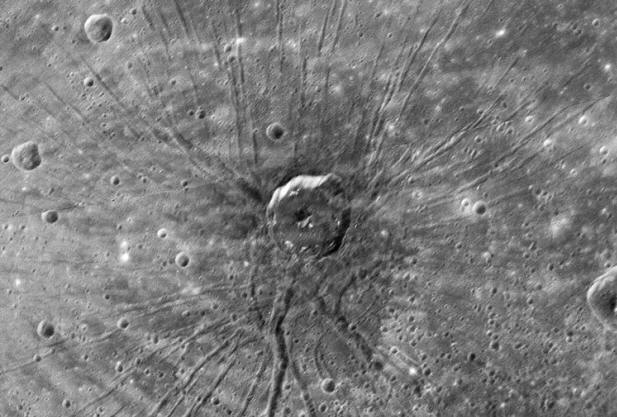
home •
about •
essential guide •
picture of the day •
thunderblogs •
news •
multimedia •
predictions •
products •
get involved •
contact
picture of the day archive subject index
“The Spider” near the center of Caloris Basin on Mercury.
Credit: NASA/Johns Hopkins University Applied Physics Laboratory
Carnegie Institution of Washington.
Jul 03, 2008
Mercury’s Araneidal Terrain“Spiders” appear where you least expect them. Some are found on Mars and now they have been seen on Mercury. Are electric discharges responsible for both?
In our last Picture of the Day article about Mercury, the chaotic topography and the massive cratering was attributed to some kind of extensive plasma discharge in the past. Images from the MESSENGER spacecraft, however, reveal a scarred surface that has undergone Electric Discharge Machining (EDM) and ion beam erosion on a massive scale, although Mercury is not experiencing that level of flare-up today.
So-called “spiders” are found on Mars in abundance. They are concentrated in south polar latitudes and appear when the deposits of carbon dioxide frost sublime back into gas during the Martian summer. The morphology of the various spider-like features exposes their positive and negative impressions in the rocky terrain that is buried every winter by dry-ice precipitation. Some “spider” formations are raised above the mean elevation of their surroundings, while others are deeply cut into the bedrock.
Venus exhibits a similar pattern of branching, filamentary trackways called “arachnoids”. They are massive in extent, some covering several hundred kilometers, and closely resemble giant Lichtenberg figures.
Previous Thunderbolts Picture of the Day articles reported that NASA scientists believe the Martian “spiders” could have been created by liquid erosion, perhaps water flowing in “dendritic drainage channels” over the now bone-dry planet. But what to do about “drainage” on planets whose surface temperatures exceed 400 degrees C?
On Earth, structures very much like those on Mars and Venus (and now Mercury) can be seen in arid environments where rain and wind erosion cannot be the cause of such remarkable scenery. Spider Crater in Australia appears to be the namesake for what we see on the other planets – it is located in a region where EU theorists propose that giant electric arcs touched down and excavated the landscape.
The “spider” on Mercury is found within the enormous Caloris Basin. Recent telemetry from MESSENGER indicates that the multi-ringed “impact structure” is larger than previously measured by Mariner 10 – almost 1600 kilometers in diameter. One intriguing aspect of Caloris is that it contains two offset rims with multiple “rayed” craters inside its boundaries.
As Electric Universe author and speaker, Wal Thornhill wrote:
“The huge ringed basin is an electrical scar. One of the characteristic features seen in cathodic electrical cratering, and inexplicable by impact, is terracing of crater walls. Another is the concentric ringed structure accompanying the blisters found on lightning arrestors following a lightning strike. Electric discharges always hit a surface vertically to form neat circular craters, often with flat melted floors. Impacts do not. Impacts cause little melting but extensive collateral damage. Cosmic discharges take the form of rotating pairs of Birkeland filaments, which drill into a surface to form rotary and corkscrew patterns.”
Thus the dual offset rims of Caloris Basin and the superficial rays confirm what the eminent physicist Ralph Juergens also identified as electrical effects.
Written by Stephen Smith from an idea suggested by Thane Hubbell
__________________________________________________________________________Please visit our new "Thunderblog" page
Through the initiative of managing editor Dave Smith, we’ve begun the launch of a new
page called Thunderblog. Timely presentations of fact and opinion, with emphasis on
new discoveries and the explanatory power of the Electric Universe."The Electric Sky and The Electric Universe available now!

|
|

|
EXECUTIVE EDITORS:
David Talbott, Wallace Thornhill
MANAGING EDITORS:
Steve Smith, Mel Acheson
CONTRIBUTING EDITORS: Michael Armstrong, Dwardu Cardona,
Ev Cochrane,
C.J. Ransom, Don Scott, Rens van der Sluijs, Ian Tresman
WEBMASTER: Brian Talbott
Copyright 2008: thunderbolts.info
![]()
home •
thunderblogs •
forum •
picture of the day •
resources •
team •
updates •
contact us

